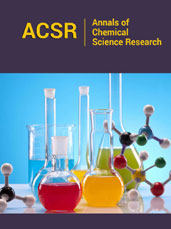- Submissions

Full Text
Annals of Chemical Science Research
L-Glucose Cyclodextrin in Drug Delivery: A Novel Excipient for Enhanced Therapeutic Performance
Fariba Heidarizadeh*
Department of Chemistry, Shahid Chamran University of Ahvaz, Iran
*Corresponding author:Fariba Heidarizadeh, Department of Chemistry, Shahid Chamran University of Ahvaz, Ahvaz, Iran
Submission: August 08, 2025;Published: September 23, 2025

Volume5 Issue1September 23, 2025
Abstract
Cyclodextrins (CDs) are cyclic oligosaccharides that are widely applied as solubilizers in pharmaceutical preparations to improve the solubility, stability, and bioavailability of active pharmaceutical ingredients. While native CDs are biologically derived from D-glucose, recent advances have introduced L-glucose cyclodextrins (L-CDs) as promising new alternatives. Due to their unique stereochemistry, L-CDs possess distinct physicochemical and biological profiles that may offer significant advantages in drug delivery systems. L-Glucose cyclodextrins are synthetically produced through recent advancements in laboratory synthesis. These compounds can be selectively functionalized with targeting ligands to enable site-specific delivery to tumors and facilitate penetration across the blood-brain barrier. Additionally, L-Glucose cyclodextrins exhibit relative resistance to enzymatic hydrolysis, though they remain susceptible to degradation by specialized enzymes known as cyclomaltodextrinases. This review discusses the structure, pharmaceutical potential, and novel applications of L-CDs, highlighting how they enable the formulation of drug design strategies.
Introduction
Cyclodextrins have been reported to encapsulate inclusion complexes with hydrophobic drug molecules for enhancing stability and solubility [1]. The native CDs, such as α-, β-, and γ-CDs, are composed of D-glucose units and are prone to enzymatic hydrolysis [2]. L-glucose cyclodextrins, however constructed from the enantiomeric analogue of glucose are resistant to enzymatic hydrolysis and exhibit unique binding affinities because of their stereochemical character [3]. Such qualities render L-CDs potential drug delivery candidates, particularly for applications requiring long-term stability, reduced metabolism, and improved safety profiles [4].
Pharmaceutical Advantages
The non-metabolizable nature of L-glucose presents many benefits in drug delivery. L-CDs do not contribute to caloric consumption or glycemic load, and therefore are particularly suitable for diabetic patients and metabolic-sensitive therapies [5]. Their enzymatic stability offers prolonged circulation and controlled drug release, while the absence of metabolic byproducts reduces the possibility of toxicity and immunogenicity. These properties enable the use of L-CDs in oral, injectable and topical formulations, especially for poorly soluble or narrowly therapeutically indexed drugs.
Applications in Drug Delivery
Although research into L-CDs is currently in its early stages, preliminary studies have already demonstrated their promise for applications in various therapeutic areas. For cancer therapy, L-CDs have been investigated for delivery of hydrophobic chemotherapeutic drugs such as paclitaxel and doxorubicin, with promising results in terms of enhanced solubility and reduced systemic toxicity [6]. Furthermore, their ability to stabilize peptides and proteins may be useful for delivery of biologics such as insulin and interferons [7]. Targeting ligand functionalization of L-CDs can also enable site-specific delivery, for example, tumor targeting or penetration through the blood–brain barrier.
Conclusion
L-glucose cyclodextrins (L-CDs) are innovative excipients with superior stability, safety and solubility compared to conventional CDs. Despite current challenges like high synthesis costs and regulatory barriers, advances in chemistry and biotechnology may enable their broader application. Continued research is crucial to harness their full potential in enhancing drug delivery and therapeutic outcomes.
References
- Sarabia-Vallejo A, Caja MDM, Olives AI, Martín MA, Menéndez JC (2023) Cyclodextrin inclusion complexes for improved drug bioavailability and activity: Synthetic and analytical aspects. Pharmaceutics 15(9): 2345.
- Braga SS (2022) Cyclodextrin superstructures for drug delivery. Journal of Drug Delivery Science and Technology 75: 103650.
- Niu X, Zhang J, Yuan M, Liu Y, Wang Y, et al. (2024) Chiral nanoenzymes: Synthesis and applications. Microchimica Acta 191(12): 723.
- Yang Z, Jaiswal A, Yin Q, Lin X, Liu L, et al. (2024) Chiral nanomaterials in tissue engineering, Nanoscale 16(10): 5014-5041.
- Javanbakht S, Poursadegh H, Darvishi S, Mohammadzadeh A, Saboury A, et al. (2025) Application or function of cyclodextrin in insulin and cell delivery for efficient diabetic treatment. Hybrid Advances 10: 100462.
- Păduraru DN, Niculescu AG, Bolocan A, Andronic O, Grumezescu AM, et al. (2022) An updated overview of cyclodextrin-based drug delivery systems for cancer therapy. Pharmaceutics 14(8): 1748.
- Zhang Y, Austin MJ, Chou DHC (2024) Insulin stabilization designs for enhanced therapeutic efficacy and accessibility. Accounts of Chemical Research 57(22): 3303-3315.
© 2025 Fariba Heidarizadeh. This is an open access article distributed under the terms of the Creative Commons Attribution License , which permits unrestricted use, distribution, and build upon your work non-commercially.
 a Creative Commons Attribution 4.0 International License. Based on a work at www.crimsonpublishers.com.
Best viewed in
a Creative Commons Attribution 4.0 International License. Based on a work at www.crimsonpublishers.com.
Best viewed in 







.jpg)






























 Editorial Board Registrations
Editorial Board Registrations Submit your Article
Submit your Article Refer a Friend
Refer a Friend Advertise With Us
Advertise With Us
.jpg)






.jpg)














.bmp)
.jpg)
.png)
.jpg)










.jpg)






.png)

.png)



.png)






